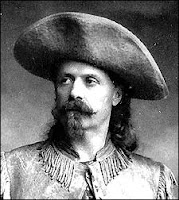 There are many examples of American Exceptionalism: The Lewis and Clark expedition. Building the Panama Canal. And of course the moon landings.
There are many examples of American Exceptionalism: The Lewis and Clark expedition. Building the Panama Canal. And of course the moon landings.And Buffalo Bill Cody and his Wild West.
Although his accomplishments are shrouded in the mists of time and exaggeration, the legendary showman was the most famous American of his time rode on wagon trains as a boy, was a Pony Express rider, a Union soldier in the Civil War, a prolific buffalo hunter, and an Army Scout in the Indian Wars for General Phil Sheridan and Colonel George Custer, and the man who got the "first scalp for Custer." But most importantly, he presented to his country and the world the classic, if not completely accurate, idea of the Wild West--and the United States as well.

Cody's America was a nation of heroic men--and women, such as the greatest target shooter of her time, Annie Oakley, Little Miss Sure Shot. Sitting Bull, who of course fought at Little Big Horn against Custer, was a member of Buffalo Bill's Wild West for a year.
Last week I finished my Four Corners Furtherance blog-o-vacation. We drove--and to get there we crossed Nebraska. Our final stop of consequence was in North Platte to see Cody's Scout's Rest Ranch. My next post will be about Buffalo Bill's grave at Lookout Mountain, Colorado which we visited the prior afternoon.
Buffalo Bill was born near LeClaire, Iowa in 1846, but grew up in eastern Kansas. He rode on his first wagon train when he was 11.

In 1878 he purchased a home in North Platte, eight years later he bought Scout's Rest Ranch. Pictured on the upper left (click on any image to make it larger), the Scout's Rest Home was built in 1886 and expanded in 1909. It's a Second Empire style structure with Italianate and Eastlake features.
Inside the home you will find period furniture and memoribilia from Cody's career, along with family photographs.

Scout's Rest was a working ranch. The two-story barn, except for the horse stalls, were blessed with wooden-plank floors, which were re-installed after the state of Nebraska purchased the property in 1965. As it was during Cody's time, the walls of the barn are adorned with posters from various Buffalo Bill's Wild West shows.

The pleasant grounds--a small stream is dammed to create a pond--includes the sod-roof Cody-North cabin, which I believe was moved there from another Cody Ranch on the Dismal River in Nebraska's Sand Hills. From that part of Scout's Rest, you can see the rise of those solitary grass-covered dunes.
Buffalo Bill's later years were sad--investments in irrigitation projects, mines, and Cody, Wyoming depleted his finances--and he lost his Wild West show, but this one man example of American Exceptionalism was not broke when he died in Denver in 1917. His money problems forced Cody to sell Scout's Rest to his friend and business partner Pawnee Bill in 1911, although members of Buffalo Bill's family lived on the ranch until 1913 before moving west to Cody's namesake town.

Cody, Wyoming eventually became very successful, the gateway town to Yellowstone receives over one million visitors annualy. A year after his death, wolframite was discovered at one of Buffalo Bill's mines. As for Scout's Rest, just south of the ranch is the home of the Buffalo Bill Rodeo. Cody's 1882 Old Glory Blow Out in 1882 is generally accepted by historians to have been the world's first rodeo.
Only America could have produced Buffalo Bill.
Next: Buffalo Bill's final resting place
Related posts:
1 comment:
I recently learned that one of my great grand uncles supposedly made a saddle for Buffalo Bill. I suppose it's possible. This uncle did live in North Platte.
Post a Comment